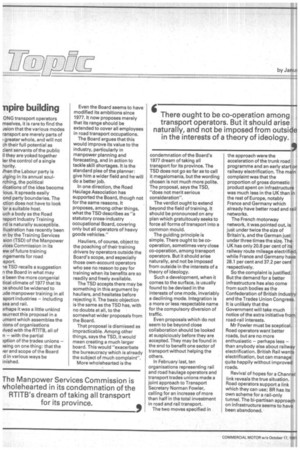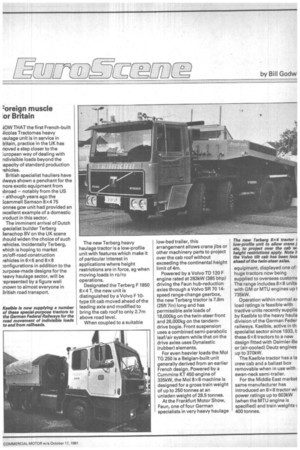npire building
Page 38

Page 39

If you've noticed an error in this article please click here to report it so we can fix it.
ONG transport operators mselves, it is rare to find the ision that the various modes ransport are merely parts of !greater whole, and will not their full potential as :lent servants of the public il they are yoked together ler the control of a single hority.
/hen the Labour party is Aging in its annual soulrching, the political ilications of the idea become ious. It spreads easily ond party boundaries. The ction does not have to look 'or a suitable host.
uch a body as the Road isport Industry Training rd is naturally susceptible. Ilustration has recently been by the Training Services sion (TSD) of the Manpower Aces Commission in its ew of future training ngements for road Sport.
TSD recalls a suggestion n the Board in what may e been the more congenial tical climate of 1977 that its Je should be widened to J de manpower training in all sport industries — including sea and rail.
arhaps it was a little unkind :surrect this proposal in a ument which assembles the lions of organisations ilved with the RTITB, all of n — with the partial
)ption of the trades unions — eing on one thing: that the ler and scope of the Board d in various ways be inished.
Even the Board seems to have modified its ambitions since 1977. It now proposes merely that its range should be extended to cover all employees in road transport occupations.
The Board argues that this would improve its value to the industry, particularly in manpower planning and forecasting, and in action to tackle skill shortages. It is the standard plea of the planner: give him a wider field and he will do a better job.
In one direction, the Road Haulage Association has supported the Board, though not for the same reasons. It proposes, among other things, what the TSD describes as "a statutory cross-industry occupational Board, covering only but all operators of heavy goods vehicles."
Hauliers, of course, object to the poaching of their training drivers by operators outside the Board's scope, and especially those own-account operators who see no reason to pay for training when its benefits are so readily and freely available.
The TSD accepts there may be something in this argument by hauliers, and hesitates before rejecting it. The basic objection is the same as the TSD has, with no doubts at all, to the somewhat wider proposals from the Board.
That proposal is dismissed as impracticable. Among other things, says the TSD, it would mean creating a much larger board. This would "exacerbate the bureaucracy which is already the subject of much complaint".
More wholehearted is the condemnation of the Board's 1977 dream of taking all transport for its province. The TSD does not go so far as to call it megalomania, but the wording chosen is not much more polite. The proposal, says the TSD, "does not merit serious consideration".
The verdict ought to extend beyond the field of training. It should be pronounced on any plan which gratuitously seeks to force all forms of transport into a common mould.
The guiding principle is simple. There ought to be cooperation, sometimes very close co-operation, among transport operators. But it should arise naturally, and not be imposed from outside in the interests of a theory of ideology.
Such a development, when it comes to the surface, is usually found to be devised in the interests of one mode, invariably a declining mode. Integration is a more or less respectable name for the compulsory diversion of traffic.
Even proposals which do not seem to be beyond close collaboration should be looked at suspiciously before they are accepted. They may be found in the end to benefit one sector of transport without helping the others.
In February last, ten organisations representing rail and road haulage operators and transport trades unions made a joint approach to Transport Secretary Norman Fowler, calling for an increase of more than half in the total investment in road and rail transport.
The two moves specified in the approach were the acceleration of the trunk road programme and an early start on railway electrification. The main complaint was that the proportion of gross domestic product spent on infrastructure was much less in the UK than in the rest of Europe, notably France and Germany which already have better road and rail networks.
The French motorway network, it was.pointed out, is just under twice the size of Britain's, and the German just under three times the size. The UK has only 20.8 per cent of its railway route mileage electrified, while France and Germany have 28.1 per cent and 37.2 per cent respectively.
So the complaint is justified. But the demand for a better infrastructure has also come from such bodies as the Confederation of British Industry and the Trades Union Congress. It is unlikely that the Government will take much notice of the extra initiative from road-rail interests.
Mr Fowler must be sceptical. Road operators want better roads, but are no more enthusiastic — perhaps less — than anybody else about railway electrification. British Rail wants electrification, but can manage quite happily without improved roads.
Revival of hopes for a Channel link reveals the true situation. Road operators support a link which they can use; BR has its own scheme for a rail-only tunnel. The bi-partisan approach on infrastructure seems to have been abandoned. JOW THAT the first French-built Jicolas Tractomas heavy laulage unit is in service in Iritain, practice in the UK has noved a step closer to the iuropean way of dealing with ndivisible loads beyond the ;apacity of standard production rehicies.
British specialist hauliers have ilways shown a penchant for the nore exotic equipment from !broad — notably from the US although years ago the >cammell Samson 8x4 75 onnes gcw unit had provided an Ixcellent example of a domestic goduct in this sector.
The imminent arrival of Dutch ;pecialist builder Terberg 3enschop BV on the UK scene ;hould widen the choice of such fehicles. Incidentally Terberg, which is hoping to market )n/off-road construction tehicles in 6x6 and 8 X 8 ;onfigurations in addition to the )urpose-made designs for the ieavy haulage sector, will be -epresented by a figure well (flown to almost everyone in 3ritish road transport.
The new Terberg heavy haulage tractor is a low-profile unit with features which make it of particular interest in applications where height restrictions are in force, eg when moving loads in ro/ro operations.
Designated the Terberg F 1850 8x4 T, the new unit is distinguished by a Volvo F 10type tilt cab moved ahead of the leading axle and modified to bring the cab roof to only 2.7m above road level.
When coupled to a suitable low-bed trailer, this arrangement allows crane jibs or other machinery parts to project over the cab roof without exceeding the continental height limit of 4m.
Powered by a Volvo TO 120 F engine rated at 283kW (385 bhp) driving the Faun hub-reduction axles through a Volvo SR 70 14speed range-change gearbox, the new Terberg tractor is 7.8m (25ft 71n) long and has permissible axle loads of 18,000kg on the twin-steer front and 26,000kg on the tandemdrive bogie. Front suspension uses a combined semi-parabolic leaf/air system while that on the drive axles uses Dynalastic (rubber) elements.
For even heavier loads the Mol TG 250 is a Belgian-built unit generally derived from an earlier French design. Powered by a Cummins KT 450 engine of 335kW, the Mol 8x8 machine is designed for a gross train weight of up to 250 tonnes at an unladen weight of 28.5 tonnes. At the Frankfurt Motor Show, Faun, one of four German specialists in very heavy haulage equipment, displayed one of1 huge tractors now being supplied to overseas custom( The range includes 8 x 8 units with GM or MTU engines up t 735kW.
Operation within normal a) load ratings is feasible with tractive units recently supplie by Kaelble to the heavy haula division of the German Feder railways. Kaelble, active in th specialist sector since 1933,1: these 6x6 tractors to a new design fitted with Daimler-Be or (air-cooled) Deutz engines up to 370kW.
The Kaelble tractor has a la crew cab and a ballast box removable when in use with . swan-neck semi-trailer.
For the Middle East market same manufacturer has introduced an 8x8 tractor wit power ratings up to 603kW (when the MTU engine is specified) and train weights c 400 tonnes.








































